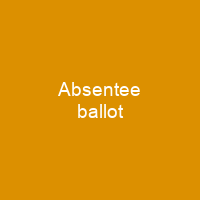Absentee voting is a vote cast by someone who is unable or unwilling to attend the official polling station to which the voter is allocated. Methods include voting at a different location, postal voting, proxy voting and online voting. Some countries require that a valid reason, such as infirmity or travel, be given before a voter can participate in an absentee ballot.
About Absentee ballot in brief

The history of absentee voting dates back to the 19th century, and modern-day procedures and availability vary by jurisdiction. Many electors are required to apply for absentee voting, although some may receive a postal ballot by default. Some jurisdictions use special paper, ballot tracking, or printing to minimize forged ballots. While postal voting has a greater risk of fraud than in- person voting, on an absolute level cases of known fraud are extremely rare. Voting by mail is sometimes controlled by using security printing, or by requiring signatures of voters and sometimes witnesses, though signature comparisons have 10-14% error rates. There is some evidence that this method of voting leads to higher turnout than one where people vote in person or have to applied for a postal vote. The reasons for allocating voters to specific polling stations are generally logistical. Some countries provide a mechanism by which voters can nevertheless cast their ballots on election day at adifferent polling station. The reason for this is generally logistical, and can be catered for by designating some larger polling stations as available for absentee Voting. In these countries, absentee voting overlaps with early voting, which is separate concepts in these countries. Some places call early in-Person voting a form of \”absentee\” voting, since voters are absent from the polling place onelection day.
You want to know more about Absentee ballot?
This page is based on the article Absentee ballot published in Wikipedia (as of Dec. 06, 2020) and was automatically summarized using artificial intelligence.







